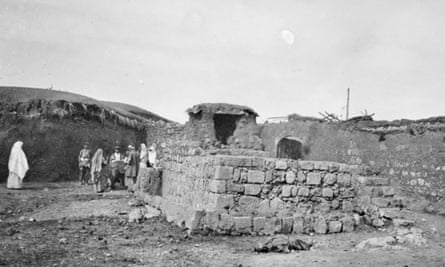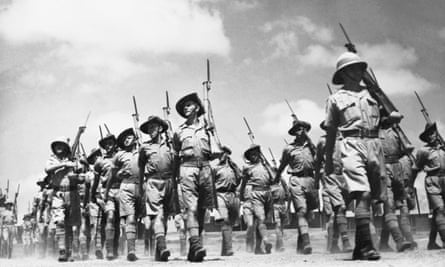The moment that forever changed my perspective on Anzac mythology
The Surafend massacre shows that the core business of good history must always be the preservation of memory

One winter’s morning a decade ago while in the late stages of archival research for a book about the Australian Light Horse in the Middle East during the first world war, I came across a file that would forever alter my perspective on Anzac mythology.
In the Australian War Memorial that morning I read an anodyne description of a voice file – a recording of Private Edward “Ted” Harold O’Brien from C Squadron of the 3rd Light Horse Regiment, most of whose members hailed, like him, from Tasmania.
A summary said that O’Brien talked about horses, his work after the war, his time as a linesman in Palestine and of his visits to the pyramids in Egypt. Interesting - but nothing extraordinary, given all I’d already read about the battlefield experiences of his fellow horsemen.
I was about to look elsewhere when another sentence caught my eye: “New Zealanders and Australians went to Bedouin village and killed the men with bayonet and broke up the buildings.”
My book was at that point LARGELY about the remarkable achievements of the light horsemen (who were for all their agility, stealth, bush-craft and warrior skill, effectively the Special Air Service of their day) as they helped drive the Ottoman troops from the Suez canal in early 1916 across Palestine and to final defeat at Damascus and beyond in late 1918.
O’Brien’s words, recorded in 1988 when a very old man, described how the Australian horsemen, based on the coastal plain of Palestine after war’s end in December 1918, “went out to this village and they went through it with a bayonet”.
Oh yes, our squadron was there. I was down there. I don’t know what I did with it, I was cranky and that. But they had a good issue of rum and they did their blocks.”
Just how badly the Anzacs did their blocks when it came to murdering all of the males older than 16 in the Arab village of Surafend 100 years ago would become evident to the British, Australian and New Zealand military officials in the days and months afterwards during a series of secretive inquiries that swept the truth into the corners of history.
This event was to me starkly at odds with the heroic reputation of the light horsemen as I’d known it, based on most of the official – and many unofficial – records I’d come across to that point.
While the Surafend massacre had been relegated to the furthest edge of the Anzac record, including in Henry Gullett’s official history of Australian troops in the Middle East, it naturally caused me to rethink the book, Beersheba, and, not least, to re-examine the primary sources and literature I’d already read.

I spent more months in the Australian and British archives trawling through patchy accounts of private military inquiries and the letters and diaries of government and military officials. At the 100th anniversary of the massacre, it’s worth recalling – given the $600m worth of remembering Australia had dedicated to the bravery and “sacrifice” of the Anzacs – just how they behaved, and what apparently inspired them, at Surafend.
It helps to understand the Anzac attitude to the nomadic Bedouin and the town Arabs of Palestine. The Australians did not distinguish between them. The letters and diaries of the Australian horseman are replete with critical impressions of both.
Gullett wrote how the Bedouin “prowled round [sic] the edge of the battlegrounds ready to tear uniforms and boots from the fallen and even to dig up and strip the dead”.
They were, he wrote, “Scarcely higher in civilisation than the Australian blacks – these wretched tribes presented a miserable and starved appearance.”
I found Gullett’s racially-charged comparison of the Bedouin to Indigenous people from Australia echoed everywhere in the private writings of the soldiers and their Australian commanders. In the context of Surafend they would later point me to a homegrown attitude, especially in rural Australia (from where the earliest light horse regiments were drawn and where massacres proliferated throughout the 19th and well into the 20th centuries) that rendered the dark-skinned inferior and easily dispensable.
The warrior wordsmith Ion Idriess, a member of the 5th Light Horse Regiment, wrote: “They snip our wounded and dig up our dead, and steal everything they can lay their hands on. But far worse than this they are spies ... And yet we are warned to leave the Bedouins strictly alone.”
After the 1918 armistice the Australians and New Zealanders from the three brigades of the Anzac Mounted Division were camped near the Jewish settlement of Richon le Zion, close to the Mediterranean and Tel Aviv. The Australians particularly were well known and liked by the Jews, if not the local Arabs. There was plentiful food and alcohol and while the men waited to repatriate, they were kept busy with drill, horse racing, football and cricket games.
The Bedouin were on the outskirts of the camp, which was also near the Arab village Surafend whose residents, it was said, stole where they could from the Anzacs.
On the night of 9 December 1918, 21-year-old New Zealand Trooper Leslie Lowry chased a thief who’d tried to steal his kitbag. He caught the robber who shot Lowry through the chest. Lowry died.
According to a letter written in 1936, Trooper Ambrose Stephen Mulhall of the 1st Australian Light Horse Regiment, reckoned Lowry “told his comrades before he died the thief and his murderer was a Bedouin and that he had gone to the Bedouin [Arab] village”.
Patsy Adam-Smith, who in her seminal book The Anzacs perhaps did more than any other mid-late 20th century Australian writer to lionise and mythologise the “diggers”, deals with what happened next perfunctorily, with questionable accuracy and in prose that searches for equivalence.
The troops, a mixed bunch of Australians, New Zealanders and Scots, raided the village in their anger and undoubtedly killed men there. One report states that they threw villagers down a well and rolled a large grindstone down on top of them. Their excuse was that they were sick of the natives stealing; for five years they’d put up with their small private possessions from home being stolen as well as their uniforms and gear, were weary of their men being ambushed and killed while the authorities did nothing.”
The revered Australian bush bard, Banjo Paterson – who served the 1st Australian Imperial Force remounts in Egypt – brought more light and shade to his description than Adam-Smith could summons. Yet he still sought to diminish the role of the Australians in his account of how the New Zealanders “and their blood brothers the [Scottish] Highlanders organised a revenge party”.
A few Australians went along with them – there couldn’t be any trouble on any front without an Australian being in it – and the revenge party followed the thief to his village, recovered the stolen goods and killed every able-bodied man in the village. Then they threw the bodies down the well, filled the well up, burnt the village, and retired in good order …”
Paterson fails to capture the premeditated nature of the revenge attack that was planned after the Arab chiefs refused to surrender the thief/murderer on the day of the 10th. The reprisal was carefully planned for 7pm on the evening of the 10th, and the men – including a good many Australians – determined to arm themselves with bayonets, axe handles and sharpened sticks, to get all of the women and children out of the village, to kill all males over 16 and to burn the village.
Afterwards they also killed men at the nearby Bedouin camp and torched it.

The Scots blamed the New Zealanders. The New Zealanders blamed the Australians. The Australians blamed the New Zealanders and the Scots.
The official inquiries were a whitewash, so comprehensively did most of the men lie to protect one another. Accounts vary as to the death toll. The evidence suggests it was between about 40 and 100. No Anzac or Scottish soldier was ever held responsible for the murders at Surafend or the Bedouin camp, or for the destruction of the village. The Empire did not, however, let the matter go, insisting Australia and New Zealand compensate the British (which had the mandate on Palestine) for the cost of replacing the village (£2060.11.3) if not for the actual killings.
In 1921 Australia (which never contested its liability) got in early with a successful compensation offer of £515.2.9. New Zealand, which had insisted it should pay no more than an equal share, eventually paid £858.11.5 (a tacit admission in covert diplomatic terms at least, that New Zealand had played a greater part in the massacre). It was blood money.
The issue lingered on the edge of the public sphere well into the 1930s when the former light horseman, Mulhall, badgered a raft of MPs (among them Robert Menzies, Gullett, and the former commanders of the 1st and 3rd Light Horse Regiments, Charlie Cox, by then a senator, and George Bell, speaker of the house) in a deluded attempt to prove the Australians had played no part in the massacre. The politicians knew the truth and fobbed Mulhall off.
A few days after the massacre the British commander of the Egyptian Expeditionary Force, Edmund Allenby, addressed the Anzac Mounted Division. He was whistled at and counted down as he stood in his stirrups atop his black stallion, Hindenburg, to declare that they were a bunch of murderers. He wiped his hands of them for good.
Harry Chauvel, the Australian cavalryman and commander of the Desert Mounted Corps (the biggest mounted column of men and beasts to traverse the Middle East since Alexander the Great) leant on Gullett to omit the massacre from the official history. Gullett, to his credit, having sought guidance from the chief war historian Charles Bean, included a four-page account in his 848-page official history.
Chauvel later wrote, “There are a few ‘incidents’ in the Australian official history. I would miss out anything about the Surafend affair. It should never have been mentioned in the Australian Official History and has been long forgotten in Australia.”
But good history can never be preoccupied with forgetting. Its core business must always be the preservation of memory.
Australian crimes against humanity such as Surafend (it would have been a war crime had it not occurred after the armistice) rated no mention in the $600m commemoration of the first world war. The war memorial does not feature what happened in its displays.
But its archive does hold part of the truth, in its archival documents and recorded voices.
Not least that of old Ted O’Brien, who said, “They all went for the men with the bayonet and they got it.”

No comments:
Post a Comment